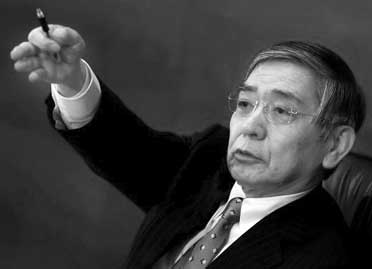Friday Dec 12, 2025
Friday Dec 12, 2025
Saturday, 30 April 2016 00:00 - - {{hitsCtrl.values.hits}}
 Reuters: The Bank of Japan held off from expanding monetary stimulus on Thursday, defying market expectations for action even as soft global demand, an unwelcome rise in the yen and weak consumption threatened to derail a fragile economic recovery.
Reuters: The Bank of Japan held off from expanding monetary stimulus on Thursday, defying market expectations for action even as soft global demand, an unwelcome rise in the yen and weak consumption threatened to derail a fragile economic recovery.
The yen surged the most against the dollar and the euro in nearly six years as the decision caught investors off guard, while the Nikkei share average sank 3.6%.
BOJ Governor Haruhiko Kuroda left the door open for more stimulus, stressing there were no limits to what monetary policy can do to address strong risks to the outlook.
“There’s absolutely no change to our stance of aiming to achieve 2% inflation at the earliest date possible, and to do whatever it takes to achieve this,” Kuroda told a news conference. “If needed, we can deepen negative rates much more.”
At Thursday’s rate review, the BOJ decided to maintain its pledge to increase base money at an annual pace of 80 trillion yen ($ 732 billion) via aggressive asset purchases. It also left unchanged a 0.1% negative rate it applies to some of the excess reserves that financial institutions park at the BOJ.
“I think the odds of (monetary easing) were half and half, but the most surprising point is that the markets seemed to have been surprised,” said Masashi Murata, a currency strategist at Brown Brothers Harriman.
“The most important point is that BOJ, especially Kuroda, would like to save its weapons and power for an emergency.”
In a separate move, the BOJ created a 300 billion yen loan program offering funds at zero interest to banks in areas hit by this month’s earthquake in southern Japan.
Kuroda defended the decision to keep policy unchanged, saying that a steady improvement in the economy allows the BOJ to spend some time studying the effect of its past easing steps.
“We took pre-emptive action by adopting negative interest rates in January ... Now is the time to see how the effect of our policies spread to the economy,” he said.
Kuroda said the positive effects of negative rates would begin to spread to the economy before the end of the year.
“We won’t deploy ammunition in small increments ... That doesn’t mean that once we take action at a certain meeting, we will hold off on action at the next meeting or leave, say, six months in between policy changes.”
The BOJ next meets for a rate review in mid-June, followed by a more crucial meeting in late July where it conducts a quarterly review of its growth and inflation projections.
“For now, the BOJ is in a wait-and-see mode to judge the effects of its negative rate policy, said Hidenobu Tokuda, senior economist at Mizuho Research Institute.
“Eventually, I think the BOJ will lower the interest rate further into negative territory later this year, perhaps after the July (upper house) election.”
The BOJ also cut its inflation forecasts in a quarterly review of its projections on Thursday. And it once again pushed back the timing for hitting its 2% price target, by six months, saying it may not happen until March 2018 at the latest. The decision came in the wake of data that showed consumer prices slipped in March at the fastest pace in three years while household spending fell at the sharpest rate in a year, adding pressure on the BOJ to do more to spur growth.
Household and corporate inflation expectations have weakened despite the BOJ’s decision in January to add a 0.1% negative rate to its massive asset-buying program.
The BOJ has been in a bind, with many central bankers worried about the gloomy outlook but increasingly reluctant to use their diminishing policy ammunition.
Kuroda tried to counter growing market views that the BOJ is running out of options, saying he saw no trouble with the bank’s bond-buying operations.
He also dismissed the idea of “helicopter money,” or underwriting government debt so the money can go directly to citizens, saying that it was impossible to adopt it under current Japanese law.
“Having said that, I don’t think there are limits to monetary policy.”